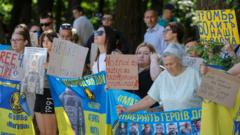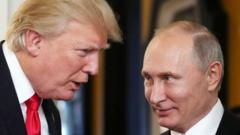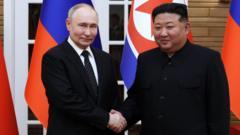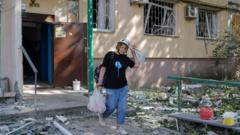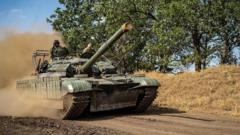As the Trump-Putin summit looms, discussions around potential territorial swaps in Ukraine spark fears of forced adjustments amid ongoing conflict. With Russia's ambitions still strong, Ukraine’s leadership faces tough decisions over land holdings critical to national integrity.
Tensions Rise Ahead of Trump-Putin Summit as Territorial Swaps on the Table
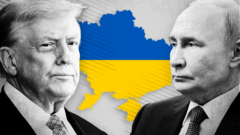
Tensions Rise Ahead of Trump-Putin Summit as Territorial Swaps on the Table
Amid growing speculation, the impending Trump-Putin summit in Alaska raises concerns over potential changes to Ukraine's borders, provoking reactions in Kyiv and Europe.
In the lead-up to the highly anticipated Trump-Putin summit on Friday in Alaska, the prospect of altering Ukraine’s geopolitical boundaries has ignited speculation and concern among global observers. Since Russia's annexation of Crimea in 2014, the situation has continued to evolve, with Russian advances in various regions prompting fears of further destabilization.
Initially, Russia’s takeover of Crimea was achieved with minimal violence, but this was quickly followed by the eruption of conflict in the eastern Donbas region, where Russian-backed separatists aggressively pushed for control over the regions of Donetsk and Luhansk. The protracted conflict has seen significant loss of life on both sides, including approximately 14,000 Ukrainian casualties before Russia’s full-scale invasion in February 2022.
In the early days of the invasion, Russian troops made rapid gains, capturing substantial territory in the south of Ukraine, including critical areas in the Zaporizhzhia and Kherson regions. However, as of now, Russian control has diminished to about 20% of Ukraine, a decline from the 27% held in the spring of 2022. Presently, President Volodymyr Zelensky has pushed for an immediate ceasefire, a sentiment echoed by Ukraine’s European allies. Meanwhile, Donald Trump has emerged with proposals for territorial trades, raising alarm in the Ukrainian government and Europe over potential concessions that would fundamentally alter Ukraine’s sovereignty.
While specific details remain murky regarding Trump’s reference to potential land swaps, the implications are dire. Analysts speculate that Putin might demand further territorial concessions in Donetsk and Luhansk, areas that are vital for Ukraine not only strategically but also symbolically, given the heavy toll inflicted on Ukrainian soldiers defending these regions. For Ukraine to concede these territories would be a devastating blow, giving Moscow a significant strategic boost following massive losses in the conflict.
Recently, Russian forces have escalated their efforts near Dobropillya, prompting a flurry of media speculation on whether this maneuver is intended to demonstrate strength going into the summit or signals a calculated strategic advancement. The situation remains tense around the captured regions of Zaporizhzhia and Kherson, where Russia claims to be open to a ceasefire, but it is unclear whether this implies a readiness to relinquish any ground.
Trump's vague comments about "ocean-front property" seemingly hint at discussions around control over parts of Ukraine's coastline, integral to Russia's land bridge to Crimea. Yet, relinquishing territory is unlikely for Putin, who views these areas as rightfully part of Russia after a series of controversial referendums.
For Ukraine and its allies, any suggestion of altering borders at this stage is unacceptable and poses risks that could exacerbate the conflict. A sustainable discussion on future borders might only emerge after a ceasefire is established and guarantees for Ukraine's security are assured. As the summit approaches, the stakes remain high, with the global community watching closely.



